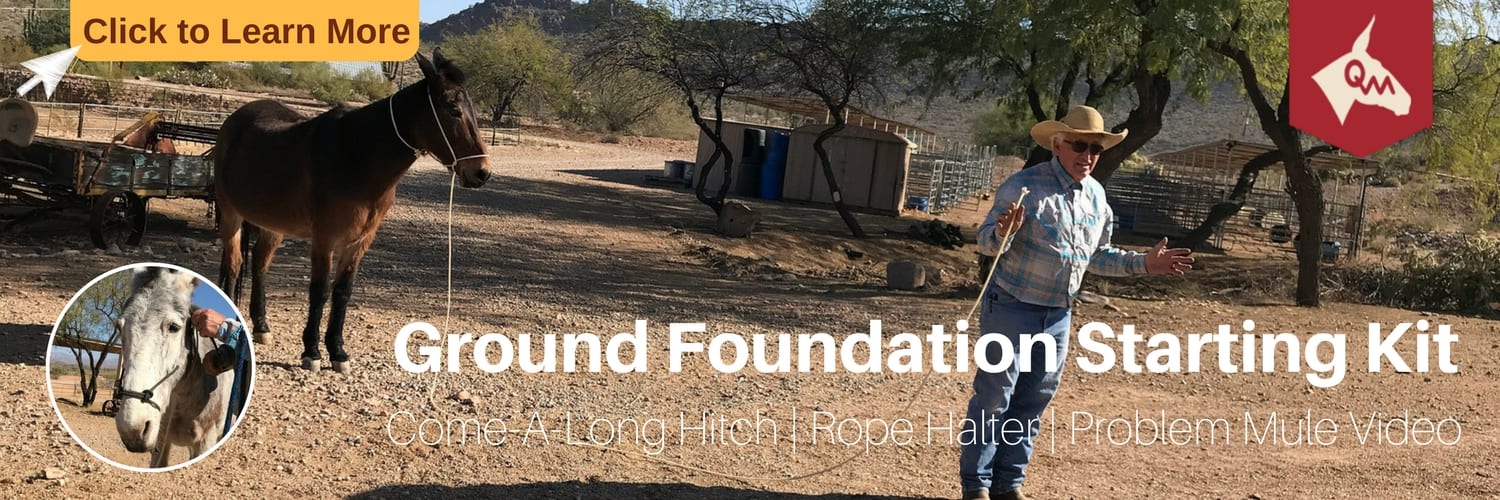We Were Doing Fine Until My Mule Bolted
Of all the emails and phone calls I receive, the most common and often the most desperate sounding ones center around mules that bolt. For no apparent reason and seldom with warning, someone’s mule took off like a rocket and scared the heck out of the rider or even worse, resulted in a crash. The caller usually says that the trust has been broken, the relationship severely damaged, and in some cases, the owner is wanting to sell the mule because of this event. They contact me to ask why it happened. They want concrete answers and they want them fast. Despite years of experience with mules and donkeys, I don’t have one simple answer. But I can offer a bit of a “checklist” which might explain a bolt. I cannot guarantee it will never happen again, but I can give you some things to look at to try to make sure you minimize your chances of a bolt.
When I look at a mule that had a behavior event, I often start by looking at the mule in his environment. And these are the questions I ask.
Is Your Mule Healthy?
- Does he appear in good physical condition with no obvious injuries or sources of pain?
- Have his teeth been floated routinely?
- Is his farrier care up-to-date and are shoes in place if you need them?
- Does he move easily and show good flexibility, muscle tone, and activity?
- Has he been seen by a chiropractor, massage therapist, or vet lately? This is especially important if he has not worked routinely.
- Is his feed appropriate for his activity? Most mules don’t need sweet feed.
- Does he get adequate turn out? If trail riding is the only outdoor time he gets, he will be frisky.
Does Your Mule Have A Good Foundation?
- Is your mule respectful of you on the ground?
- Does he lead well?
- Does he stand for grooming, tacking, and mounting?
- Have you refreshed his groundwork before starting your trail season and then periodically throughout the season?
- Does he understand that you are the leader?
- Does he clearly understand cues?
- Are his trailer manners intact?
- Does he tie well and ground tie?
- Does he only move when you ask him to move?
Are You Using The Correct Tack To Promote Comfort And Compliance?
- Is your saddle a good fit for your animal and for you?
- Is your saddle pad one that supports the saddle and prevents slipping?
- Have you selected the appropriate bit for his level of training?
- Do you have a breast collar and britchen and are they fitted correctly?
- Do you have both cinches in place, connected together, with the back being the tighter of the two?
- If you are using saddle bags or carrying items, have you secured them and have you introduced them to your mule before you take that long trail ride?
- Are your reins ones that you can easily handle?
Have You Done What You Can To Manage Behavior Issues?
- Is your mule buddy or barn sour?
- Can your mule comfortably ride alone or does he need a buddy or group?
- Are you the regular rider?
- Are you a confident leader?
- Are you able to address behavior issues calmly and confidently, or does your mule scare you?
- Are you riding with reliable trail partners?
- Do you have realistic expectations?
By now, you are saying, “Steve – you ask too many questions!” Well, there are these issues and many more possible causes for a mule bolt. And there are no shortcuts. You need to look at each and every one of these points and be brutally honest.
If I had to pick the most common areas where I most often find room for improvement – I would select these five:
- Many mules do not have a solid training foundation. Owners want to ride so they cut corners; the end result is that the mule does not have a solid foundation that will save him and his rider.
- The mule’s teeth have not been tended to. For some reason, people don’t seem to be as regular about floating a mule’s teeth as they are with horses.
- The saddle is one that pinches or stabs the scapula area of the mule. You can’t just set a saddle on and go. If your mule bolts while on hills, especially going down hills, it is almost certainly his saddle that is the issue.
- The bit is wrong for the mule. Lots of mules play with their bits. And thinking that you can control a mule with a bit is shear folly. The bit is a communication tool. Fit it well and use the bit that is appropriate for your mule’s training level.
- You are not a confident leader. I often hear people say that the mule is smart so they let him make the decisions. Well, you can sure let him have input – but you have to be in control and there must be consequences for behaviors that show disrespect.
Now again, I am not suggesting that you skip any of the other evaluation steps or that you ignore other possibilities. Sometimes an animal will just spook and take off – mule or horse, this can happen.
So How Can We Put This All Into Practice?
Here is an actual client story:
This rider lives in an area where there is a lot of snow and cold in winter. The lady is older, so she is not a fan of winter riding. She turns her mule out each day all year round and her mule gets good quality first cut hay and a ration balancer (no sweet feed!). In summer, she is on pasture as well. The mule is regularly vetted, sees a massage therapist, gets her teeth floated every year, and has an excellent tack package (not to brag, but she selected my saddle, pad, britchen, breast collar, cinches, and correction bit). Each spring, she refreshes her mule’s training in the round pen. During those cold winter months, she also works in the stall on this mule, keeping her supple, flexible, and obedient about picking her feet up, standing for grooming, etc. After several round pen sessions, she takes the mule on some walks around her farm. She can evaluate how the mule is moving and how she responds to seeing things she will see on the trail. This all happens BEFORE that first spring ride. This has been her practice for five years.
This spring, while taking her mule for a walk, the molly spooked and took off. She pulled the rope away from the woman and ran around like a crazy animal with no provocation and no obvious issue. She was hard to catch, but when she was finally caught, the owner, being confident that this was not a physical issue but a behavior one, put the mule immediately into corrective work. Now, what does that mean?
It means she picked up the lead rope and took the molly who was winded and tired from her excursion, and put her in the round pen and had her work – and work hard. She did circles at a trot and a canter, she backed, she side passed, did figure eights, she yielded her hinds and her fores and she did it some more. There were no breaks. The molly was soaked with sweat and just wanting to eat after her walkabout – but the owner said, “No! – you want to run around, we will run around – you decided, not me.” After about 30 minutes of strenuous work and once there was complete and total obedience and submission, the woman let the molly slow down and let her stop. But still no food. She then did a thorough grooming and left the molly tied for another 30 minutes until she cooled down. Then she was walked back to a small paddock and placed on a dry lot for the remainder of the afternoon with fresh water and a salt block. She let the mule digest this experience and three days later, she took the mule for a walk in the same areas and she jokingly says that the mare was so quiet and slow that she had to “check for a pulse.”
In other cases, you need to evaluate possible physical causes. A mule that is generally very good but has an issue going downhill through ditches may have a saddle problem. A mule that throws his head around and then takes off may have a tooth or bit problem. A mule who consistently fails to respond to seat, leg, and rein cues likely has a foundation hole. Be a detective! You can probably even add to the list above when it comes to checking things out. But know that bolting does not have a single cause. There is no stock answer. And when you call me for help, I will ask a lot of questions. I will ask you to send me pictures. I will ask you about the training you have done and how your mule did with those lessons. My answers may only be as good as the information you give me. But in many cases, you can answer the questions yourself if you follow the checklist.
I don’t consider any question a dumb question. Please feel free to give me a holler!
- Posted in: Articles, Everything
- Tagged: Articles, Everything




1 thought on “We Were Doing Fine Until My Mule Bolted”
i dont ride my mule often, i am older. once we were riding along a paved road on the side of it where there us hadly any traffic. one car came and slowed down and crept by us. the molly was fine the next car came up fast on us then slammed on brakes when i yelled at him, then got right beside me and squalled tires and stomped on the gas as hard as he could. my molly took off running and when we went around a curve i fell off hard. she stopped in a few minutes, breathing heavily and trembling. i feel this was a freak accident and no fault of her own.. i couldnt stop her tho. what do you think?